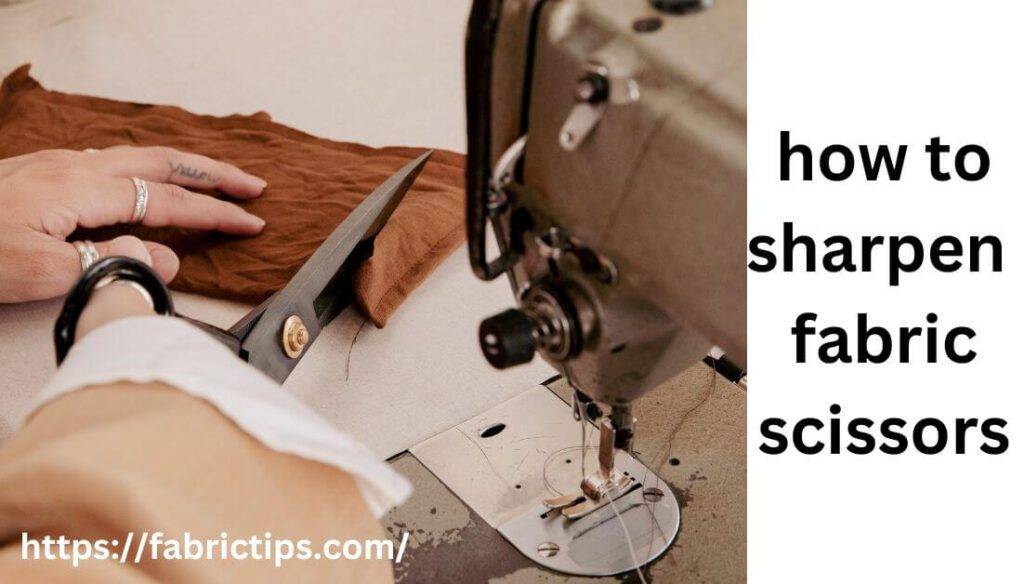Last Updated on December 13, 2025 by Wahid
Fabric cutting should be one of the easiest parts of your craft project. However, when using blunt scissors, cotton & felt can be difficult to handle even before you get started. A sharp pair of scissors will be a valuable asset in sewing kits, although they don’t have to be replaced regularly.
Purchasing new scissors would greatly increase your monthly budget, but that can be avoided with a little maintenance. By following our helpful tips, you will learn how to sharpen fabric scissors at home. You can keep your fabric scissors sharp by using common household items, which will save you time and money on replacing them.
However, you can sharpen sewing scissors in 5 ways at home, including some tricks you might not have thought of. Well, let’s check out what ways and tips are waiting for you.
How To Sharpen Fabric Scissors: 5 Methods & Step-by-Step Instructions
No matter what your sewing skill level is, fabric scissors can be sharpened. If you use professional sharpening tools or household materials, you’ll get longer-lasting sharpness. It is only necessary to perform the task correctly.
Method 1: “Using A Sharpening Stone”
Many people use a whetstone or sharpening stone first. Well, owning one at home wouldn’t be a bad idea. Actually, it’s an effective method for sharpening fabric scissors. In addition, the process is simple & traditional.
Understanding The Basics
- Whetstones are used for sharpening knives, as are bench stones for fabric scissors.
- Basically, it consists of two sides, a fine one and a coarse one.
- Most commonly, coarse stones have 400-grit while fine stones have 1000-grit.
- Nonetheless, if you have dull scissors, you should begin using them on coarse surfaces.
- Then, if you only require slight sharpening, start with the fine edge of your sharpening stone.
- Continue following the instructions.
Surfaces Of Stone Should Be Wet
- To achieve better honing, water or honing oil should be applied to the stone surface.
- As a result, the scissor blade will move back & forth more easily.
Disassemble The Blades
- To ensure proper sharpening, take out the screw from the blades before sharpening.
- Each blade will be sharpened individually.
- Furthermore, it provides maximum mobility.
- However, flathead screwdrivers can be used to remove screws.
Hone The Scissor Edge
- First, place one blade’s inner surface against the stone. Using the blade, apply pressure from the coarser end towards the surface.
- Using light pressure, move the blade along the length of the stone. Take the stone from its base around its tip.
- Your cutting edge and the inner blade should be at a sharp angle.
- Thus, hold the handle tightly and pull it slowly toward your body.
- Every stroke should be done correctly. But even with a dull blade, you won’t need more than a dozen strokes.
Sharpen The Cutting Edge
- Scissor blades are beveled on the edges that meet the inside part of the cutting edge.
- Defining the cutting edge is as simple as tilting it.
- You will see it lying horizontally.
- Then, slide the blade forward after pulling it over the bench stone.
- Maintain a flat beveled edge throughout the process.
- The cutting edge should be sharpened properly by continuing this process.
Lastly, Dispel All Rough Burrs
- Finally, after you have finished honing, your blade’s edge will have some metal burrs.
- When you reassemble your scissor blades, remove them and open them and close them again.
- Using scissors, you can cut a variety of materials, such as fabric, paper, and cardboard.
- As a result, the blades will be free of any trace amounts of burrs.
Pro Tips
- Due to the complexity of the process, try sharpening an old pair of scissors first. Sharpening fabric scissors requires some practice.
- During sharpening, you can follow a trick if you find our formula complicated. Make a line across the blade’s cutting edge.
- Next, sharpen it. Eventually, sandpaper and an eraser will remove the marker line.
- For a smooth & nice blade finish, pass the stone over the finer surface as well.
- The sharpening procedure should be repeated to get a sharp edge.
Method 2: “Using Sandpaper”
Whetstones or sharpening stones can be used when fabric scissors are overly dull and damaged. However, if your fabric cutters still work but not perfectly, sandpaper may be able to help. This process can be used to maintain scissors that cut roughly.
Sandpaper With A Fine Grit Works Well
- You should use sandpaper that has a grit of 150 to 200.
- Nevertheless, if your scissors aren’t dull, you can also use one with a finer grit.
- As a result, your scissor’s blades will be smoother.
- When the rough side of the sandpaper faces outwards, fold its edges in half.
- Both the blade and the sandpaper will graze each other when cutting.
Slicing Sandpaper With A Scissor
- Then, with a dull fabric scissor, repeatedly cut the sandpaper folded in half.
- During cutting, ensure that both sides of the blade are completely covered with sandpaper.
- Make 10 to 20 long sandpaper strips this way.
- Blades become sharper with each strip cut.
- Having the blades smoothed out this way also helps to prevent indents & nicks.
- Even so, some materials are offered that work just as well as sandpaper.
- You can use steel wool and emery cloth for all of these.
Pro Tips
- The scissors should be tested after cutting more than 10 strips. The test can be done with scrap fabric.
- Once you are happy with the sharpness of the edges, you are finished.
- Make them sharper if necessary by cutting more strips & notches.
Method 3: “Using Aluminum Foil”
Using aluminum foil to sharpen fabric scissors is very similar to using sandpaper. During this process, just aluminum foil is used. Yet, dull-edge scissors can also benefit from this. Aluminum foil cannot be used to sharpen very dull scissors. Make sure you follow the steps.
Get Some Aluminum Foil
- This purpose requires aluminum foil paper between 8 and 10 inches long.
- The paper should now be folded multiple times lengthwise.
- The strip should appear thick and long.
- Adding layers to aluminum foil involves folding it multiple times.
- The blades of scissors are sharpened by it.
Using Scissors, Cut Strips
- When the foil is folded correctly, use scissors to remove thin strips from the paper.
- Cut through the thick and tightly rolled aluminum foil until you reach the end.
- Be sure to use the scissor’s full stroke when cutting the paper.
- Cut the foil paper with an extended blade until the tip is reached.
Eliminate Aluminum Debris
- The blades will certainly accumulate aluminum foil particles during the slicing process.
- Therefore, this must be eliminated.
- Using a warm paper towel, wipe away any aluminum debris.
- The blades should then be wiped with it.
Pro Tips
- Aluminum foil strips vary in width, so scissors must be sharpened accordingly.
- Hence, an increased folding thickness, which is more sharpenable. Every cut can be sharpened several times with additional layers.
Method 4: “Using A Mason Jar”
Fabric scissors can also be sharpened in a glass mason jar. As well as sharpening dull scissors, is a very simple procedure.
Wrap The Scissors Tightly Around The Jar
- First of all, make sure the scissors are tightly wrapped around the jar.
- Using scissors, open them wide and cover the outside surface of the mason jar with the blades.
- The jar should be taken as close to the blade’s edges as possible.
Mason Jar Pretends To Be Cut
- Make the jar look like it has been cut with scissors while holding it with one hand.
- As a result, whenever the scissors slide, the blades will make an impact on the mason jar.
- However, you should not apply heavy pressure when applying scissors.
- Using light pressure, carry out the process.
- In the mason jar, glass material will be used to sharpen the knife.
- Continue sharpening the scissors until they are sharp enough.
Take The Glass Out
- As the process continues, some microscopic glass pieces will be collected by the blades.
- Hence, damp paper towels are ideal for wiping them down.
Pro Tips
- Due to the blade edges scratching the jar, use one that is damaged.
Method 5: “Try Sewing Needles & Pins”
- Make sure your scissors are positioned, with both blades holding the sewing pin.
- Then start gently, compressing the scissors as you go.
- Thus, the sewing pins move up from the very bottom, where the blades meet, until they reach the top.
- Simply apply a little more pressure, continuing to cut across the pin with your blades.
- Continue to sharpen them until you are satisfied that they are sharp enough.
- After you’ve cleaned your scissors, wipe them down using a damp fabric, then check them out.
- If you’re not satisfied, repeat, but make sure your needles & pins can withstand wear.
Please Note
- After following the above-mentioned procedures, fabric scissors can be sharpened using a variety of methods and materials.
- As with sandpaper and Alum foil paper, steel wool soap pads can also be used for cleaning fabric scissors.
- Additionally, you can sharpen sewing scissors with a pin and screwdriver, only following the method for mason jars.
- However, rotary tools are also commonly used when scissors are badly damaged or dull.
- Finally, select the option you think will best suit your needs.
How To Clean Scissors
- After frequent use, most gunk will be easily removed with water & dish soap.
- Experts advise applying paint thinner (under well-ventilated conditions) to clean the blades of scissors to remove sticky residue.
- If the glue has dried on, use acetone nail polish remover and a sponge with rough sides.
- For rusted blades due to water or age exposure, wipe them with white vinegar-soaked cotton balls.
- Every few months, oil the screw area of the blades’ joint. By doing so, the blades remain smooth and friction-free.
- Before using the scissors again, remove all the extra oil.
How To Store Scissors
- Each time you need scissors, you have to dig through a cluttered drawer, which is the wrong storage place for them.
- This banging can damage them, chip the blades, crack the tips, or cause them to become misaligned.
- If you want your scissors to stay sharp between sharpenings, ensure they’re always closed when they’re not in use. Keeping them in something is the best thing you can do.
- A pair of scissors often comes with a sheath, pouch, and gift box; in that case, you should keep them. Protect the scissors by storing them in them.
- When the scissors weren’t packaged with one, make a felt sleeve.
- Keep scissors away from humid places, for example, the bathroom; humidity can cause rust on the scissors.
How To Properly Use Scissors
- Choose the best pairs that are designed for specific jobs: fabric scissors for sewing, and paper scissors designed for crafts, & wrapping. By doing this, all blades will remain sharp for a longer period of time.
- As you use scissors, wrap linen and cotton twine around the handles to make them easier to grip.
- Using 5 feet of twine, roll it into a small bundle that will fit through your finger holes.
- As you work around one handle, hold the loose end under your thumb, making sure to loop it over the handle as you go.
- Twist the bundle around the loop, then pull tightly to form a half-hitch. Keep working on the handle, forming a herringbone design along its outer edge with knots.
- Keep in mind, any scissors used on paper will dull.
- Therefore, make sure your fabric scissors are clearly marked to prevent those more expensive ones from being used on paper.
What Makes Scissors Sharpening Difficult At Home
Sharpening scissor blades correctly requires training. You might experience the following if you lack specialist training:
- A wrong angle is used to sharpen the scissors. Angles are used differently by different brands.
- You should remove the hole/gap that is supposed to be there inside the blades. This is referred to as a ‘blade set’.
- The blades have been nicked accidentally.
- Excessively tighten the scissors, thus causing the blades to crush together.
- Without professional training and accurate tools, it’s easy to make mistakes.
FAQs
01. Can you sharpen fabric scissors with aluminum foil?
Because sharpening implies the creation of a sharpened edge on the blade, not cutting your kitchen foil won’t sharpen it. Prior to disposing of the foil & blades, you should know that a dull blade can be extended by using tin foil.
02. What is the best way to sharpen scissors at home?
Scissors should be sharpened on ceramic plates, diamonds, or rods, or on belt sharpeners such as the “Original Work Sharp Knife & Tool Sharpener.” A honing rod will work if you do not have these tools or even an item of hardened steel used for drilling.
03. Can dryer sheets sharpen scissors?
Yes, it’s simple: Just make several cuts with your scissors on a dryer sheet. As you are snipping away, your blades will be sharpened by the sheet. Dryer sheets can also be used to remove grease & grime from blades. After using scissors, wash them with soap & water.
04. What household items can you use to sharpen scissors?
“Tin Foil”:- You can sharpen your blades with tin foil from your kitchen. You can cut the foil with scissors by cutting across it. This should make the blade much less dull if you do it on both sides. If your blades are really dull, overlap several layers of tin foil, then cut your way through.
05. Does cutting sandpaper ruin scissors?
The surface of sandpaper isn’t smooth, causing burns, cuts, or an uneven surface for your blade. Using them for a long period of time can also alter the angle at which the blades were sharpened. As a result, while the scissors might feel sharper, they might also cause long-term damage.
06. Is WD40 good for scissors?
When you use the WD-40 Multi-Use Product, you will be able to remove rust in just a few minutes. In addition to this, you can use it for cleaning gym equipment, sanitizing bikes and cards, removing adhesive from furniture, and many other household chores.
07. What oil do you use for fabric scissors?
“Sewing machine oil” is recommended. Unless you have this option, use neutral cooking oils like vegetable or avocado oil.
08. Why won’t my scissors cut after sharpening?
Do scissors not cut properly after they have been sharpened? There is likely to be a problem with the blade edges not gliding against one another when the rivet or pivot screw is loose.
09. What is the best angle to sharpen scissors?
Whenever sharpening scissors, keep in mind that the angle of the bevel is about 75° to 80°, steeper than an average knife’s bevel. It is always important to hold the handle of the scissors you plan to sharpen so that you can maintain control.
10. Does cutting sandpaper really sharpen scissors?
You can transform blunt scissors with sandpaper, restoring them to like-new condition. Sandpaper should be folded in half so the rough sides face outwards. Use full strokes when cutting the sandpaper – working from the base to the top of the blade. Slowly, the blade will be sharpened with sandpaper.
Final Verdict
You all know how to sharpen fabric scissors. The above-mentioned 5 techniques are some of the most common ways to sharpen fabric scissors. Hopefully, with this guide, you now know exactly how to sharpen sewing scissors without needing any special skills. Careful execution of some technical steps is always necessary.
Depending on the situation of your scissors, you should apply one of the methods to sharpen them. Sharpening tools are for incredibly dull scissors, and everything else is for mildly dull scissors.
Basically, sharpening fabric & with pinking scissors is best done by a professional sharpener. Approximately $7 – $20 will be charged. Ideally, you should carry out this every couple of years.


